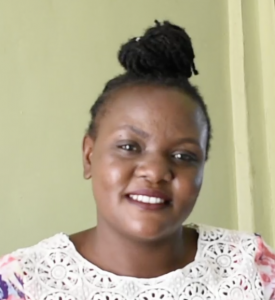"The discharge pipe is very low, making the process of drawing water to be difficult. The spring box is open, frogs keep on jumping inside, and you can easily draw water with frogs in it," explained teenager Belinda as she described what it is like to fetch water from Olingo Spring.
Belinda lives in Shianda Township and goes to school at St. Peter's Khabakaya Secondary. If we can help protect Olingo Spring, she will be able to access clean water both at home and at school.
Though 350 people in Shianda Township depend on Olingo Spring for all of their daily water needs, they are not able to fetch clean and safe water from the spring. As Belinda noted, the community tried to install a discharge pipe directly into the earth, but it had to be placed very low to the ground to catch any water at all.
Community members' jerrycans and buckets cannot stand upright beneath the pipe, so they are forced to use smaller jugs and bowls to collect water that they can then pour into their larger containers. Often, the small pool of water below the pipe mixes with the water coming out of the pipe.
The process is long, tiresome, and frustrating.
"Sometimes you can get a long queue drawing water, making you wait for long before drawing water. The water is open and it can be easily contaminated," said Nathan Olingo, a farmer and the spring's landowner.
The area around the spring is slippery and muddy, making it difficult to find even footing while fetching water. People's feet often, though accidentally, stir up the mud in the water they are trying to fetch. So does the discharge pipe if someone's bucket nudges it. The spring is predominantly contaminated by surface runoff, which carries farm chemicals, animal waste, and human waste due to the lack of latrines and consequent open defecation in this area.
The dirty water from Olingo Spring is holding back everyone who drinks its water from reaching their full potential. The many contaminants in the water mean that people often contract water-related illnesses and have to spend their resources on medical treatment. Kids miss school and adults miss productive work time when they are forced to stay home while sick.
What We Can Do:
Spring Protection
Protecting the spring will help provide access to cleaner and safer water and reduce the time people have to spend to fetch it. Construction will keep surface runoff and other contaminants out of the water. With the community’s high involvement in the process, there should be a good sense of responsibility and ownership for the new clean water source.
Fetching water is a task predominantly carried out by women and young girls. Protecting the spring and offering training and support will, therefore, help empower the female members of the community by freeing up more of their time and energy to engage and invest in income-generating activities and their education.
Training on Health, Hygiene, COVID-19, and More
To hold trainings during the pandemic, we work closely with both community leaders and the local government to approve small groups to attend training. We ask community leaders to invite a select yet representative group of people to attend training who will then act as ambassadors to the rest of the community to share what they learn. We also communicate our expectations of physical distancing and wearing masks for all who choose to attend.
The training will focus on improved hygiene, health, and sanitation habits in this community. We will also have a dedicated session on COVID-19 symptoms, transmission routes, and prevention best practices.
With the community’s input, we will identify key leverage points where they can alter their practices at the personal, household, and community levels to affect change. This training will help to ensure participants have the knowledge they need about healthy practices and their importance to make the most of their water point as soon as water is flowing.
Our team of facilitators will use a variety of methods to train community members. Some of these methods include participatory hygiene and sanitation transformation, asset-based community development, group discussions, handouts, and demonstrations at the spring.
One of the most important issues we plan to cover is the handling, storage, and treatment of water. Having a clean water source will be extremely helpful, but it is useless if water gets contaminated by the time it is consumed. We and the community strongly believe that all of these components will work together to improve living standards here, which will help to unlock the potential for these community members to live better, healthier lives.
We will then conduct a small series of follow-up trainings before transitioning to our regularly scheduled support visits throughout the year.
Training will result in the formation of a water user committee, elected by their peers, that will oversee the operations and maintenance of the spring. The committee will enforce proper behavior around the spring and delegate tasks that will help preserve the site, such as building a fence and digging proper drainage channels. The fence will keep out destructive animals and unwanted waste, and the drainage will keep the area’s mosquito population at a minimum.
Sanitation Platforms
At the end of the training, participants will select 5 families that should benefit from new concrete latrine floors called sanitation platforms. Training will inform the community and selected families on what they need to contribute to make this project a success. They must mobilize locally available materials, including bricks, clean sand, and gravel.
The 5 families chosen for sanitation platforms must prepare by sinking a pit for the sanitation platforms to be placed over. Our trainers then instruct them on how to build superstructures over their new platforms. These 5 sanitation platforms will serve as examples for the rest of the community to replicate.
All community members must work together to make sure that they continuously provide accommodations and food for the work teams throughout all stages of spring and sanitation platform construction.

 Protected Spring
Protected Spring
 Rehabilitation Project
Rehabilitation Project

















































